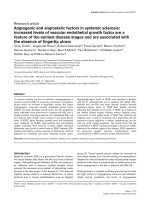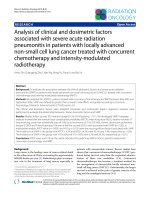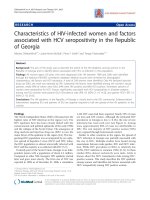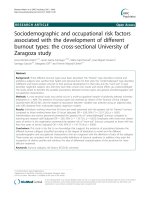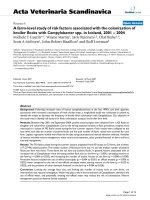Factors associated with embryonic mortality of eggs of Vanaraja breeder chicken reared on deep litter system
Bạn đang xem bản rút gọn của tài liệu. Xem và tải ngay bản đầy đủ của tài liệu tại đây (271.15 KB, 8 trang )
Int.J.Curr.Microbiol.App.Sci (2019) 8(4): 525-532
International Journal of Current Microbiology and Applied Sciences
ISSN: 2319-7706 Volume 8 Number 04 (2019)
Journal homepage:
Original Research Article
/>
Factors Associated with Embryonic Mortality of Eggs of Vanaraja Breeder
Chicken Reared on Deep Litter System
Sujata Dey1*, Rajarshi Samanta2, Subhransu Pan2,
Bikas Debnath3 and Asish Debbarma4
1
2
Govt. of Tripura, India
Department of Livestock Production Management, West Bengal University of Animal and
Fishery Science, 37, K. B. Sarani, Kolkata-700037, India
*Corresponding author
ABSTRACT
Keywords
Vanaraja,
Embryonic
mortality, Pre
incubation storage,
Egg shape index,
Shell thickness
Article Info
Accepted:
07 March 2019
Available Online:
10 April 2019
The present study was aimed to explore embryonic mortality pattern of fertile eggs of
Vanaraja chicken reared on deep litter system. The study was conducted in the year 2016
at Hatchery Unit of West Bengal University of Animal and Fishery Sciences, Mohanpur
campus (Nadia District). Birds were divided in 3 age groups as 27 to 40, 41 to 72 and 73 to
92 weeks. Eggs were grouped into three categories; 38 to 41.3, 41.6 to 54.8 and> 55g.
Eggs were stored with the small end pointed downward for 1, 2, 3, 4, 5, 6 days and 86,
144, 140, 156, 155, 148 numbers of eggs, respectively, introduced to the setter. There was
no significant effect of flock age, egg weight, pre-incubation storage (p<0.05) on
embryonic mortality but significant difference was seen in embryonic mortality when
shape index is >75% with both egg shape index range i.e. 64 to 71.96 and 72 to 74.97%,
but no significant difference among 64-71.96 and 72-74.97%. There was significant
difference in embryonic mortality when shell thickness was 0.22 to 0.31 mm with both
shell thickness groups i.e. 0.15-0.21and >0.32 mm, but no significant differences was
found in between 0.15-0.21 mm and >0.32 mm shell thickness groups. Results from this
study concluded that embryonic mortality of eggs of vanaraja chicken was influenced by
shell thickness and shape index of eggs.
range farming system. The embryonic
mortality of domestic fowl (Gallus gallus
domesticus), has progressively increased day
by day, previously when flock sizes were
small the embryonic mortality rarely
exceeded 10% (Alexis and Romanoff, 1949).
Payne (1919) observed embryonic mortality is
especially high between third and fifth days of
incubation and again on nineteenth day
Introduction
The demand of poultry and its products in
India is very high as it has no ethical issues.
Introduction of improved breeds, strains,
varieties shows an increasing trend in the
production. Project Directorate on Poultry
(ICAR), Hyderabad has developed a suitable
germplasm i.e. Vanaraja for backyard or
525
Int.J.Curr.Microbiol.App.Sci (2019) 8(4): 525-532
approximately. To increase reproductive
efficiency, it is necessary to assess the
infertility and embryonic mortality that leads
to hatching failure. Hatching failure results
from two main causes: ova failed to be
fertilized or fertilized egg failed to hatch in
addition to embryonic mortalities occurred at
any stage of development (Birkhead et al.,
2008). Approximately 20% of eggs normally
did not hatch; the majority of this expected
percentage of embryonic mortality occurred
during the first and last weeks of incubation
(Lyons, 2003). The most influential egg
parameters are: egg weight, shell thickness
and egg shape index. The average value of the
egg quality traits are required for the
embryo’s development. Effect of these
parameters along with age and pre-storage
time on hatching failure leads to embryonic
mortality which have been discussed in this
study.
is the ratio between maximum egg width with
maximum egg length (Narushin and
Romanov, 2002) and represents a numeric
value of egg shape. Many researchers
(Narushin and Romanov, 2002; King’ori,
2011) have suggested that the hatching
performance achieved with normal shaped
eggs are greater than that achieved with
abnormal shaped eggs.
Therefore, the aim of our study was to
determine the effect of flock age and egg
weight, pre-incubation storage period, egg
shape index and egg shell thickness on
embryonic mortality of Vanaraja Chicken
reared under deep litter system of rearing.
Materials and Methods
The present study was conducted at Hatchery
Unit, WBUAFS, Mohanpur campus (Nadia
District) under Poultry Seed Project, 2009 on
fertile eggs Vanaraja chicken reared under
deep litter system for a period from
December, 2015 to May, 2016.
Increasing the number of storage days
increases the proportion of embryonic
mortality during storage and incubation and
thereby increased the probability of failure to
hatch (Whitehead et al., 1985; Yoo and
Wientijes, 1991; Scott and Mackenzie, 1993).
Influence of the number of storage days
before incubation on proportion of embryo
died up to 7th day of incubation, i.e. early
embryonic mortality and on the proportion of
embryos that died from day 8 to day 21 of
incubation, i.e. late embryonic mortality, have
been assessed among fertile eggs (Yoo and
Wientijes, 1991; Scott and Mackenzie, 1993).
There are two phases of increased embryonic
mortality during incubation: the first phase
occurs during the first week of incubation and
the second phase during the last week (Payne,
1919; Byerly, 1930).
Flock information
Vanaraja chicken were reared in deep litter
system with well ventilated and lighted
houses. Litter was in good condition i.e. dry,
without dust, crust and moulds. There were
sufficient feeder (pellet form feed) and
automatic drinking (ad libitum) system.
Deworming was done monthly. Vaccination
was done according to the schedule. Five
batches of flock were considered for the study
and they were divided into three age groups
as 27 to 40, 41 to 72 and 73 to 92 weeks.
Egg collection and cleaning
Egg shape depends on the anatomical
structure of hen, particularly of the oviduct,
internal organ distribution and shape of pelvic
bones (King’ori, 2011). The egg shape index
Total 18 numbers of hatching and 886
numbers of unhatched eggs were observed.
Fertile eggs were collected after 2 weeks of
first laying at 27 to 40 weeks of age. Eggs
526
Int.J.Curr.Microbiol.App.Sci (2019) 8(4): 525-532
were collected three times daily, one time in
the morning and two times in the afternoon.
Eggs were uniform in shape, colour with good
sound shell quality were selected for hatching.
of eggshell thickness (mm). The shell
thickness of the egg was measured using an
electronic
ABSOLUTE
DIGIMATIC
CALIPER (Mututuyo, Japan).
Determination of egg weight
Egg shell thickness = (pointed end+ equator+
blunt end)/3
All eggs were weighed individually and
recorded daily to the nearest gram and
averaged for each replicate by means of
electronic digital weighing balance during the
whole study and grouped into three category;
category 1- 38 to 41.3g, category 2- 41.6 to
54.8g, category 3 – more than 55g.
Determination of embryonic mortality
Early death: Dead in shell within the day 7
of incubation grouped under early death.
There was appearance of vascularisation, start
of organogenesis, head and trunk was visible,
embryo having C shape with limbs and beak
development. Early death (%) was calculated
as number of embryos dying in early
phase/number of unhatched eggs x 100.
Storing of fertile eggs
The eggs were kept in cold storage at 170C
and 75% relative humidity. Eggs were stored
with small end pointed downward for 1, 2, 3,
4, 5, 6 days with86, 144, 140, 156, 155, 148
numbers of eggs, respectively, introduced to
the setter.
Mid death: Dead in shell onward 8th day of
incubation till 15th day, categorised under mid
death. Feather development starts, limb and
eyelid
developed,
viteline
membrane
surrounds the yolk sac completely and head
turns towards broad end (aircell). Mid death
(%) was calculated as number of embryos
dying in mid phase/number of unhatched eggs
x 100.
Determination of egg shape index
Maximum breadth and maximum length was
recorded in micrometer to determine the egg
shape index of all unhatched eggs. The length
and width of the eggs at the broadest points
were measured with the help of an electronic
ABSOLUTE
DIGIMATIC
CALIPER
(Mututuyo, Japan) sensitive to 0.00 mm.
Late death: Dead in shell onwards 16th day
of incubation categorised under late death.
They were as follows:
Unabsorbed yolk sac, covered by
amnion, unhealed naval or sometimes bloody
naval of the embryo was also present.
Embryo was in pipping position i.e.
head was under right wing, full term
development dead in shell. An embryo that's
full-term and not pipped, with a yolk sac that's
large, possibly with residual albumen or not
enclosed by the abdominal wall.
Pierce the inner membrane of shell but
dead in shell.
Pipped or cracked the shell but unable
to hatch out.
Shape index was estimated using Shultz
(1953) formula:
S.I. (%): (Egg width/Egg length) × 100
Determination of egg shell thickness
After exposing the embryo, the shell
membrane was separated from shell and its
thickness measured. Thickness of broad end,
small end and middle of shell was taken and
average determined as egg shell thickness and
could be considered as a valid measurement
527
Int.J.Curr.Microbiol.App.Sci (2019) 8(4): 525-532
Live embryo within the shell but dead
after taken out the shell with severe bleeding.
Anomalies like: crossed beak, missing
beak, missing eye, double pair of legs,
exposed brain were observed.
viz. Roque and Soares (1994), Lapaoet al.,
(1999), Almeida et al., (2008), Salahi et al.,
(2012) found that flock age significantly
affected the embryonic mortality in older
broiler breeder. In the present study,
embryonic mortality irrespective of period of
incubation is found to be minimum in 41 to
72 weeks of age of the flock.
Late death (%) was calculated as number of
embryos dying in late phase/number of
unhatched eggs x 100.
Effect of
mortality
Statistical analysis
The replicate pens were the experimental
units and all data obtained were pooled
replicate wise. The results were expressed as
mean, standard error of mean and mean
percentage. The data were subjected statistical
analysis (Snedecor and Cochran.1994) in the
Statistical Package for Social Sciences (SPSS
21.0, Chicago, IL, USA).
egg
weight
on
embryonic
The effects of egg weight on embryonic
mortality i. e. early, mid and late death (%)
are tabulated in the table 1.
The observations revealed that there is no
significant effect (p>0.05) of egg weight on
embryonic mortality. Early and mid death (%)
were maximum for41.6 to 54.8 g weighed
eggs with a mean percentage of 29.41 and
24.16, whereas late death (%) occurred
mostly when egg weight is more than 55 g
with a mean percentage of 55.08. Lower
early, mid and late death (%) differed in
significantly for38-41.3g, >55 g and 41.654.8g weighed eggs respectively.
Results and Discussion
Effect of flock age on embryonic mortality
The effects of flock age on embryonic
mortality i. e. early, mid and late death (%)
are tabulated in the table 1.
The observations of the present study are
consistent with the findings of Fesenko et al.,
(1992a/b?), Elamin et al., (2015) who
concluded that egg weight had no significant
effect on embryonic mortality in broiler
breeder flocks.
The findings demonstrated that there is no
significant effect of flock age (p>0.05) on
embryonic mortality. Late death % (death
occurred in last stage of incubation) is
occurred maximum insignificantly with a
mean percentage of 53.85, 53.61 and 48.93 in
73-92 weeks, 27-40 weeks and 41-72 weeks
of flock age respectively than early death (%)
and mid death (%).
However there are some observations which
disagree with these findings; Alabi et al.,
(2012), Ng’ambiet al., (2013), Rashid et al.,
(2013), Iqbal et al., (2016) revealed that egg
weight significantly affected large sized eggs
are associated with higher mortality.
The results of the present study are in tune
with the findings of Zakaria et al., (2005),
Alsobayel and Albadry (2012), Awad and ElHalim (2014). They also revealed that
embryonic mortality was not significantly
affected by flock age. However there are
some studies which differ from these results
In the present study, embryonic mortality
irrespective of period of incubation is found
to be minimum in 41.6 to 54.8 g weighed
eggs.
528
Int.J.Curr.Microbiol.App.Sci (2019) 8(4): 525-532
difference existed among 64-71.96% and 7274.97%. Highest early and mid death (%)
were found when ESI is more than 75% with
mean percentage of 32.84, 33.87 and highest
late death (%) at 64 to 71.96% of ESI with
mean percentage of 57.33. Lowest early, mid
and late death (%) were observed in 7274.97%, 64-71.96% and >75% of ESI
respectively with a mean percentage of 22.15,
13.33 and 33.58 respectively.
Effect of pre-incubation storage period on
embryonic mortality
The effects of pre-incubation storage period
on embryonic mortality i. e. early, mid and
late death (%) are tabulated in the table 1.
The study showed that there is no significant
effect (p>0.05) of pre-incubation storage
period on embryonic mortality. Early death
(%) is insignificantly highest at 1st day of
storage and lowest at 2nd day of storage with a
mean percentage of 31.75 and 24.8
respectively. Mid death (%) is insignificantly
highest at 0 day of storage and lowest at 1st
day of storage with a mean percentage of
27.85 and 18.25 respectively. Late death (%)
is insignificantly highest at 4th day of storage
and lowest at 0 day of storage with a mean
percentage of 55.97 and 43.04 respectively.
The findings of the present study are in tune
with the findings of Asci and Durmus (2015)
who observed a significant effect on ESI.
However Jull and Haynes (1925) and Brar et
al., (2006) revealed that there was no
significant contribution of egg shape index in
embryonic mortality.
Effect of egg shell thickness on embryonic
mortality
The findings of the present study are similar
with the results of Fasenko et al., (1992a/b?)
who observed storage did not affect the
embryonic mortality. El-Sagheer (2012) also
found that storage of 0 to 5 days had no
significant effect on embryonic mortality.
However there are some observations which
are dissimilar to these findings. Scoot and
Mackenzie (1993), Lapaoet al., (1999),
Elibolet al., (2002) concluded in their studies
the storage had a significant effect on
embryonic mortality.
The effects of egg shell thickness on
embryonic mortality i. e. early, mid and late
death (%) are tabulated in the table 2.
The findings demonstrated a significant effect
(p<0.05) of shell thickness on embryonic
mortality. There is significant difference in
embryonic mortality when shell thickness is
0.22 mm to 0.31 mm with both shell thickness
groups i. e. 0.15-0.21 mm and >0.32 mm, but
no significant differences were found in
between 0.15-0.21 mm and >0.32 mm shell
thickness groups. At 0.22 mm to 0.31 mm
highest early death (%) occurred with a mean
percentage of 33.33, highest mid death (%)
occurred at 0.15mm to 0.21 mm shell
thickness with a mean percentage of 25.77
and highest late death (%) occurred when
shell thickness is more than 0.32 mm with a
mean percentage of 73.91.
Effect of egg shape index (ESI) on
embryonic mortality
The effects of egg shape index on embryonic
mortality i. e. early, mid and late death (%)
are tabulated in the table 2.
The observations revealed that significant
effect (p<0.05) of ESI on embryonic
mortality. There is significant difference in
embryonic mortality when shape index is
>75% with both ESI range i.e. 64 to 71.96%
and 72 to 74.97%, but no significant
The observations of the present study are in
consonance with the results of Farooq et al.,
(2001) and Murad et al., (2001) who also
found significant influences of egg shell
529
Int.J.Curr.Microbiol.App.Sci (2019) 8(4): 525-532
thickness on embryonic mortality. However
there are some observations on contrary of
these findings, Elamin et al., (2015), Malik et
al., (2015) revealed that egg shell thickness
showed no significant effect on embryonic
mortality. The effect of egg shell thickness on
embryonic mortality at different stages of
incubation may be due to inadequate nutrition
of the parent stock.
Table.1 Effect of flock age, egg weight and pre-incubation storage on embryonic mortality of
Vanaraja Chicken eggs
Embryonic
mortality (%)
Early death %
Mid death %
Late death %
Significant
Flock age (weeks)
27-40
41-72
73-92
22.89
28.68
27.69
23.49
22.39
18.46
53.61
48.93
53.85
Non significant
Egg weight (g)
38-41.3 41.6-54.8 >55
23.18
29.41
26.56
23.18
24.16
18.36
53.64
46.43
55.08
Non significant
0
29.11
27.85
43.04
1
31.75
18.25
50
Pre-incubation storage (days)
2
3
4
5
24.8
24.11 25.37
30.71
20.80 24.82 18.66
23.62
54.40 51.06 55.97
45.67
Non significant
Table.2 Effect of egg shape index and egg shell thickness on embryonic mortality of Vanaraja
Chicken eggs
Embryonic mortality (%)
Early death %
Mid death %
Late death %
Significant
Egg shape index (%)
Egg shell thickness(mm)
64-71.96 72-74.97
>75
29.33a
22.15a
32.84b
13.33a
26.35a
33.87b
57.33a
51.49a
33.58b
Values bearing different
superscripts (a, b) within the row
differ significantly(p<0.05)
0-0.21
0.22-0.31
>0.32
14.43a
33.33b
14.49a
25.77a
19.37b
11.59a
59.79a
47.29b
73.91a
Values bearing different
superscripts (a, b) within the row
differ significantly(p<0.05)
Based on the result of this study it can be
concluded that embryonic mortality was not
affected by egg weight, flock age and preincubation storage period. Whereas egg shell
thickness and egg shape index affect the
embryonic mortality. It was seen that at later
stage of embryonic development the
maximum mortality occurred, at 64-71.96%
egg shape index and an increase shell
thickness also cause a higher embryonic
mortality. So as far as embryonic mortality is
concerned, egg shape index and egg shell
thickness impart directly to the economic
contribution of Vanaraja chicken.
References
Alabi, O. J., Ng`ambi, J. W. and Norris, D.
2012. Effect of egg weight on physical
egg parameters and hatchability of
indigenous Venda chickens. Asian
Journal of Animal and Veterinary
Advances,7(2):166-172.
Alexis and Romanoff, L. (1949). Critical
periods and causes of death in avian
embryonic development. Auk. 66: 264270.
Almeida, J. G., Vieira, S. L., Reis, R. N.,
Berres, J., Barros, R., Ferreira, A. K.
and Furtado, F. V. F. 2008. Hatching
distribution and embryo mortality of
eggs laid by broiler breeders of different
ages. Brazilian Journal of Poultry
Science, 10(2): 89-96.
Alsobayel, A.A. and Albadry, M.A. 2012.
Acknowledgement
The authors would like to thank all the staffs
of
Dept,
of
Livestock
Production
Management, WBUAFS, Kolkata.
530
6
27.81
23.84
48.34
Int.J.Curr.Microbiol.App.Sci (2019) 8(4): 525-532
Effect of age and sex ratio on fertility
and hatchability of baladi and leghorn
laying hens. Journal of Animal and
Plant Science,22: 15-19.
Aşcı, E. and Durmuş, İ. (2015). Effect of egg
shape index on hatching characteristics
in hens. Turkish Journal of Agriculture.
3(7): 583-587.
Awad, A. L. and Abd El-Halim, H. A. H.
(2014).Some hatching traits in sinai
chicken eggs as affected by flock age,
dietary ascorbic acid supplementation
and egg storage period under Egyptian
conditions. Egyptian Poultry Science
Journal. 34(IV): 959-978.
Birkhead, T. R., Hall, J., Schut, E. and
Hemmings, N. (2008). Unhatched eggs:
methods for discriminating between
infertility and early embryo mortality.
Ibis.105:1-10.
Brar, A. K., Brah, G. S. and Chaudhary, M. L.
(2006). Analysis of relationship of egg
weight and specific gravity with
incubation mortality in chickens. Indian
Journalof Poultry Science. 41(2): 122 –
128.
Byerly, T. C. (1930). Time of occurrence and
probable causes of mortality in chick
embryos. Proceedings of World’s
Poultry Congress. 4: 178–186.
Elamin, M. K., Malik, H. E. E., Sakin, A. I. Y.,
Elagib, H. A. A. and Dousa, B. M.
(2015). Effect of egg weight and egg
shell thickness on hatchability and
embryonic mortality of cobb broiler
breeder eggs. Global journal of animal
scientific research. 3(1): 186-190.
Elibol, O., Peak, S. D., and Brake, J. (2002)
Effect of flock age, length of egg
storage, and frequency of turning during
storage on hatchability of broiler
hatching eggs. Poultry Science. 81(7)
:945-50.
El-sagheer, M. (2012). Influence of preincubation storage duration on egg
quality,
hatchability,
embryonic
mortality and viability of Dandarawi
chicks. Egyptian Journal of Animal
Production. 49(2): 173-180
Farooq, M., Mian, M. A., Murad, A., Durrani,
F. R., Asghar, A. and Muqarrab, A. K.
(2001). Egg traits of Fayumi birds under
subtropical conditions. Sarhad Journal
of Agriculture. 17(2): 141-145.
Fasenko, G. M., Hardin, R. T., Robinson, F.
E. and Wilson, J. L. (1992a).
Relationship of hen age and egg
sequence position with fertility,
hatchability,
viability,
and
preincubation embryonic development
in broiler breeders. Poultry Science.
71(8): 1374-83.
Fasenko, G. M., Robinson, F. E., Hardin, R.
T., and Wilson, J. L. (1992b).
Variability in pre-incubation embryonic
development in domestic fowl and
effects of duration of egg storage
period. Poultry Science.71(12):2129-32.
Iqbal, J., Khanb, S. H., Mukhtara, N., Ahmed,
T. and Pashad, R. A. (2016). Effects of
egg size (weight) and age on hatching
performance and chick quality of broiler
breeder. Journal of Applied Animal
Research. 44(1): 54–64.
Jull, M. A. and Haynes, S. (1925). Shape And
weight of eggs in relation to their
hatching
quality.
Journal
of
Agricultural Research. 31(7): 685-694.
King’ori, A. M. (2011). Review of the factors
that influence egg fertility and
hatchability in poultry. International
Journal of Poultry Science. 10(6): 483492.
Lapao, C., Gama, L. T. and Soares, M. C.
(1999). Effects of broiler breeder age
and length of egg storage on albumen
characteristics and hatchability. Poultry
Science.78: 640–645.
Lyons, J. J. (2003). Small flock series:
incubation of poultry. An Agricultural
Publication. G8353.
Malik, H. E. E., Sakin, A. I. Y., Elagib, H. A.
531
Int.J.Curr.Microbiol.App.Sci (2019) 8(4): 525-532
A., Dousa, B. M. and Elamin, K. M.
(2015). Effect of egg weight and egg
shell thickness on hatchability and
embryonic mortality of Cobb broiler
breeder eggs. Global Journal of Animal
Scientific Research. 3(1): 186-190.
Murad, A., Farooq, M., Mian, M. A.,
Muqarrab, A. K. (2001). Hatching
performance of Fayumi eggs. Sarhad
Journal of Agriculture. 17(1): 1-6.
Narushin's, V. G. and Romanov, M. N.
(2002). Egg physical characteristics and
hatchability. World's Poultry Science
Journal.58: 297-303.
Ng'ambi, J. W., Thamaga, M. W., Norris, D.,
Mabelebele, M. and Alabi, O. J. (2013).
Effects of egg weight on hatchability,
chick hatch-weight and subsequent
productivity of indigenous Venda
chickens in Polokwane. South African
Journal of Animal Science. 43(5): 6974.
Payne, L. F. (1919). Distribution of mortality
during the period of incubation. J. Am.
Assoc. Instr. Invest. Poultry Husb.6: 912.
Rashid, A., Khan, S. H., Abbas, G., Amer, M.
Y., Khan, M. J. and Iftikhar, N. (2013).
Effect of egg weight on hatchability and
hatchling weight in Fayoumi, Desi and
crossbred (Rhode Island Red X
Fayoumi) chickens. Vetworld. 6(9):
592-595.
Roque, L. and Soares, M. C. (1994). Effects
of Eggshell Quality and Broiler Breeder
Age on Hatchability. Poultry Science
Association. 73(12):1838-1845.
Salahi, A., Khabisi, M. M. and Esmailizadeh,
A. K. (2012). Effects of pre-incubation
upside-down positioning of eggs from
breeder flocks with different ages on
hatchability and chick quality. Animal
Production Science. 52: 269–275.
Scott, T. A. and Mackenzie. C. J. (1993).
Incidence and classification of early
embryonic mortality in broiler breeder
chickens. British Poultry Science. 34:
459-470.
Shultz, F.T. (1953). Analysis of egg shape of
chicken. Biometrics. 9: 336-353.
Snedecor, G. W. And Cochran, W. G. (1994).
Statistical methods. 8thed.Iowa State
University Press, Ames, Iowa.
Whitehead, C. C., Maxwell, M. H., Pearson,
R. A., and Herron, K. M. (1985).
Influence of egg storage on hatchability,
embryonic development and vitamin
status in hatching broiler chicks. British
Poultry Science. 26(2):221-8.
Yoo, B. H., and Wientjes, E. (1991). Rate of
decline
in
hatchability
with
preincubation storage of chicken eggs
depends on genetic strain. British
Poultry Science. 32: 733–740.
Zakaria, A. H., Plumstead, P.W., RomeroSanchez, H., Leksrisompong, N.,
Osborne, J. and Brake, J. (2005).
Oviposition pattern, egg weight,
fertility, and hatchability of young and
old broiler breeders. Poultry Science.
84(9):1505-9.
How to cite this article:
Sujata Dey, Rajarshi Samanta, Subhransu Pan, Bikas Debnath and Asish Debbarma. 2019.
Factors Associated with Embryonic Mortality of Eggs of Vanaraja Breeder Chicken Reared on
Deep Litter System. Int.J.Curr.Microbiol.App.Sci. 8(04): 525-532.
doi: />
532

